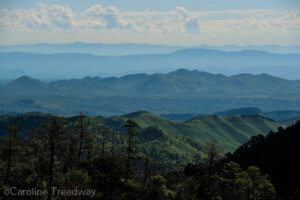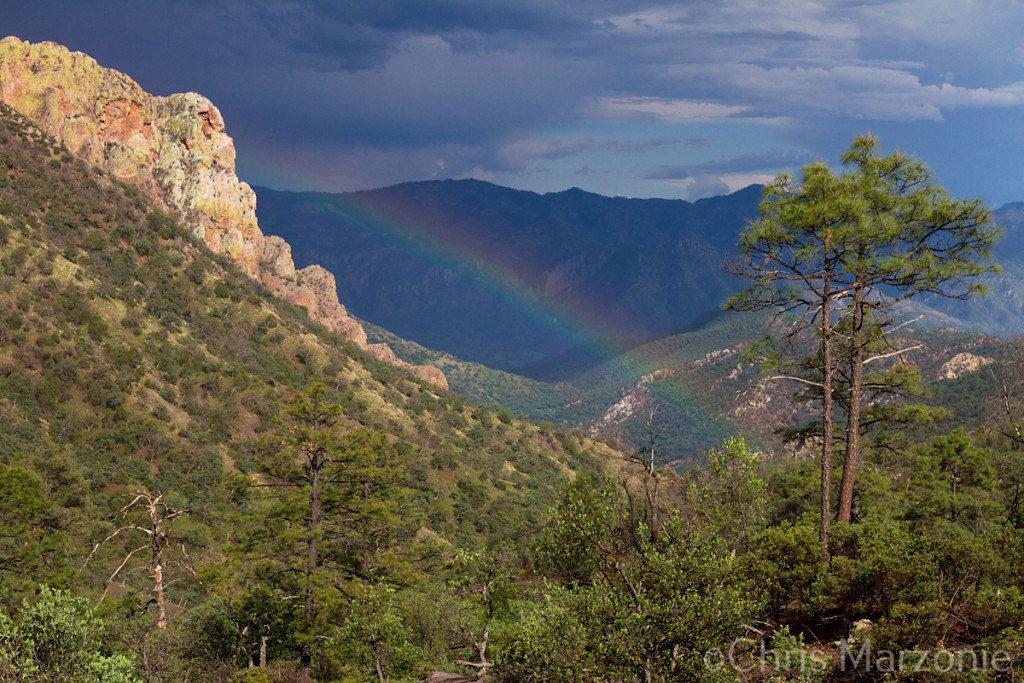
Our mountain ranges are “islands of habitat” and support hundreds of incredible flora and fauna species. Sierra Los Ajos ©Caroline Treadway
This year’s World Habitat Day was on Monday, October 5th! As communities around the globe take a moment to observe and appreciate the species and ecosystems that make up our planet, let’s also pause to celebrate the habitats—and the flora and fauna that inhabit them—that make our Sky Island region so unique and worthy of protection.
What is a habitat? The dictionary lists a habitat as being “the natural environment of an organism; the place that is natural for the life and growth of an organism.” For many flora and fauna species, the Sky Islands are perfect habitat to support their survival either almost or all year round.
Here are five of our favorite facts about Sky Island habitats:
- In the late 1960s, the scientific community agreed to consider Sky Island mountain ranges as “islands of habitat.” This means the beautiful mountains in this region are 100% wildlife habitats—from the scrub in the foothills to the towering green pines at the highest peak!
- Our Sky Island ranges support an incredible array of species. With a mix of the region’s perennial water sources, temperature ranges, and diverse elevations (from Sonoran Desert scrub at less than 4,000 feet to subalpine forests at over 9,000 feet), a large number of flora and fauna can survive—and even thrive—in a condensed amount of space.
Habitats change rapidly in the Sky Islands as elevation increases; in just a day’s walk of this region, you could climb through desert and scrubland habitats that are characteristic of central Mexico and eventually make it up to the mixed-conifer habitats typically found in Canada.
- The Coronado National Forest, which covers several of our Sky Island ranges including the Mule Mountains, Huachuca Mountains, Santa Rita Mountains, and Patagonia Mountains, is home to more threatened and endangered species than any other National Forest in the United States.
This area is an incredible hotspot for biodiversity. In fact, Defenders of Wildlife reports that there are at least 41 endangered species in this region. Some of these focal species include the jaguar, the ocelot, the Mexican gray wolf, the Mexican spotted owl, the yellow-billed cuckoo, and the Sonoran tiger salamander.
Bonus fact: Did you know that in order for a region to be called a biodiversity hotspot, it must contain “at least 1,500 species of native, vascular plants—about 0.5 percent of the species on the plant,” as well as be in great need of restorative action as a result of habitat loss (source: National Geographic)?
- Many creatures come to the Sky Islands in the spring to mate or hunt. In the fall, however, some of our well-known species migrate to Mexico to escape the oncoming cold. This migration is part of a healthy range of habitats and ensures diversity in genetics, a larger mating pool, and more opportunities for food, shelter, and water. Our jaguars, black bears, turkey vultures, and others all follow yearly migratory patterns but still rely on the Sky Island region as one of their main environments for survival.
- Some of our Sky Island mountains traverse the U.S.–Mexico border, creating uninterrupted habitat for species that don’t recognize borders or boundaries. These wildlife corridors help ensure biological diversity for both Arizona and Mexico by allowing species to seek out new habitats with replenished food sources and better winter climates. They also provide safe passage through areas of land that are otherwise developed for housing, ranching, or industrial operations.
Unfortunately, wildlife corridors are currently threatened by ongoing border wall construction. Sky Island Alliance is documenting and monitoring these migratory species to better understand what may be lost if the wall severs this important landscape.
To learn more, explore our Border Wildlife Study program.
References:

